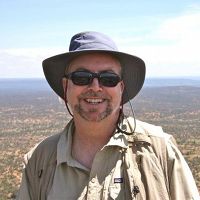Urgeghe et al., 2010
Redistribution of runoff among vegetation patch types: on ecohydrological optimality of herbaceous capture of run-on.
Urgeghe A.M., Breshears D.D., Martens S.N., and Beeson P.C. (2010)
Rangeland Ecology and Management, 63: 497-504,
-
Catalina-Jemez, INVESTIGATOR
Abstract
A central tenant of ecohydrology in drylands is that runoff redistribution from bare to vegetated patches concentrates the key limiting resource of water, which can then enhance vegetation growth and biomass. Conversely, a reduction in vegetation patches, particularly those associated with herbaceous plants, can lead to a threshold-like response in which bare patches become highly interconnected, triggering a large increase in hillslope runoff and associated erosion. However, generally lacking is an assessment of how maximization of run-on to herbaceous patches relates to minimization of hillslope-scale runoff. To illustrate how runoff redistribution potentially changes in response to conversion of herbaceous patches to bare ones, we used a spatially distributed model, SPLASH (Simulator for Processes at the Landscape Surface–Subsurface Hydrology), with an example of a semiarid piñon–juniper woodland hillslope with seven combinations of bare and herbaceous patch cover, culminating in complete loss of herbaceous patches, for a 1-yr design storm. As expected, the amount of hillslope runoff increased curvilinearly with reductions in herbaceous cover as runoff per cell increased from bare patches and run-on per cell increased for herbaceous patches. Notably, the total amount of run-on to all herbaceous patches was greatest when the amount of bare cover was intermediate, highlighting a trade-off between the source area for generating runoff and the sink area for capturing run-on. The specific nature of patch–hillslope runoff redistribution responses certainly depends on several site-specific conditions, but the general nature of the response exhibited in our example simulation may be indicative of a general type of response applicable to many rangelands. We suggest that a more robust suite of such relationships could be valuable for managing rangelands by enabling explicit accounting for optimality and trade-offs in biomass per herbaceous patch, total herbaceous cover, and prevention of hillslope-scale connectivity of bare patches that triggers a large increase in runoff and associated erosion.
Citation
Urgeghe A.M., Breshears D.D., Martens S.N., and Beeson P.C. (2010): Redistribution of runoff among vegetation patch types: on ecohydrological optimality of herbaceous capture of run-on . Rangeland Ecology and Management, 63: 497-504,. DOI: 10.2111/REM-D-09-00185.1
 This Paper/Book acknowledges NSF CZO grant support.
This Paper/Book acknowledges NSF CZO grant support.
Explore Further

